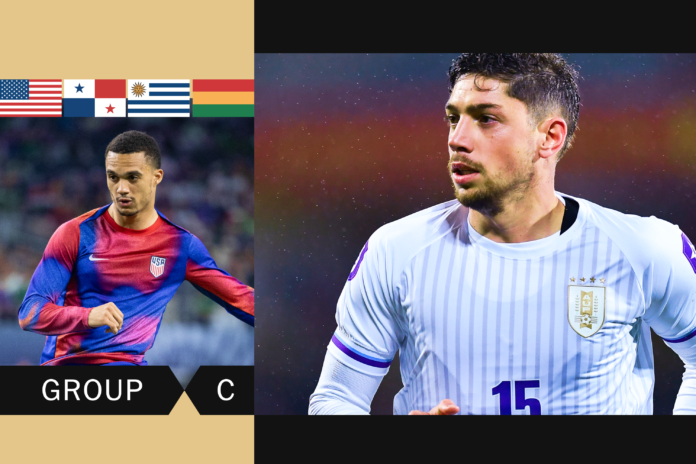Welcome to The Athletic’s tactical group guides for the Copa America. How will the U.S. adapt to a key injury at the back? Why are Bolivia so poor on the road? And are Uruguay really capable of going all the way?
The 2024 Copa America is just around the corner, as six CONCACAF nations battle it out with 10 South American sides to win international football’s oldest prize.
Thom Harris will look at each team’s playing style, strengths, weaknesses, key players and highlight things to keep an eye on during the tournament.
On to Group C, where the hosts face one of the favourites, the up-and-comers, and the rank outsiders.
Uruguay
- Manager: Marcelo Bielsa
- Captain: Jose Maria Gimenez
- World Cup qualifying: P6 W4 D1 L1 GF13 GA5
- 2022 World Cup: Group Stages
- Most caps in squad: Luis Suarez (138)
- Top scorer in squad: Luis Suarez (68)
How do they play?
Uruguay is South America’s second-smallest country, sandwiched right between its two biggest. But after an emphatic start to the Marcelo Bielsa era, recording consecutive wins over Argentina and Brazil in World Cup qualifying, it is a nation riveted with the belief that it can secure a record 16th continental crown.
Bielsa’s appointment last May — a manager nicknamed El Loco for his obsessive preparation and fearless tactical approach — is momentous for more reasons than one. This will be Uruguay’s first Copa America campaign without veteran manager Oscar Tabarez in two decades, while his eccentric successor is just the second foreign coach in their history. He is Argentinian —who are neighbours, rivals, and the other nation that holds 15 Copa America titles going into this year’s competition.
Narrative aside, Bielsa’s intense methods look like they gel with a spirited group of players, already fizzing with the energy and desire required to implement his aggressive system.
On paper, the formation is a 4-2-3-1, but the roles within it are fluid, dictated by surges of pressure around the ball. Grizzled centre-backs are flanked by strong full-backs and protected by a destroyer-creator duo of Manuel Ugarte and Rodrigo Bentancur, while the physicality and forward momentum of both Federico Valverde and Darwin Nunez are game-breakers on the counter.
When they can dominate possession, Uruguay are not afraid to commit waves of men forward to overload the opposition’s defensive line. In the build-up to their very first goal under Bielsa, a quick one-two triggers three forward runs into the box, with six players up ahead of the ball.
Rodrigo Zalazar picks out a floated pass for Facundo Pellistri, who lays the ball back for Matias Arezo to score.
The movement is drastic, but the sheer variety of box-crashing runs means plenty of forwards are sniffing around the penalty area, even if the ball drops loose.
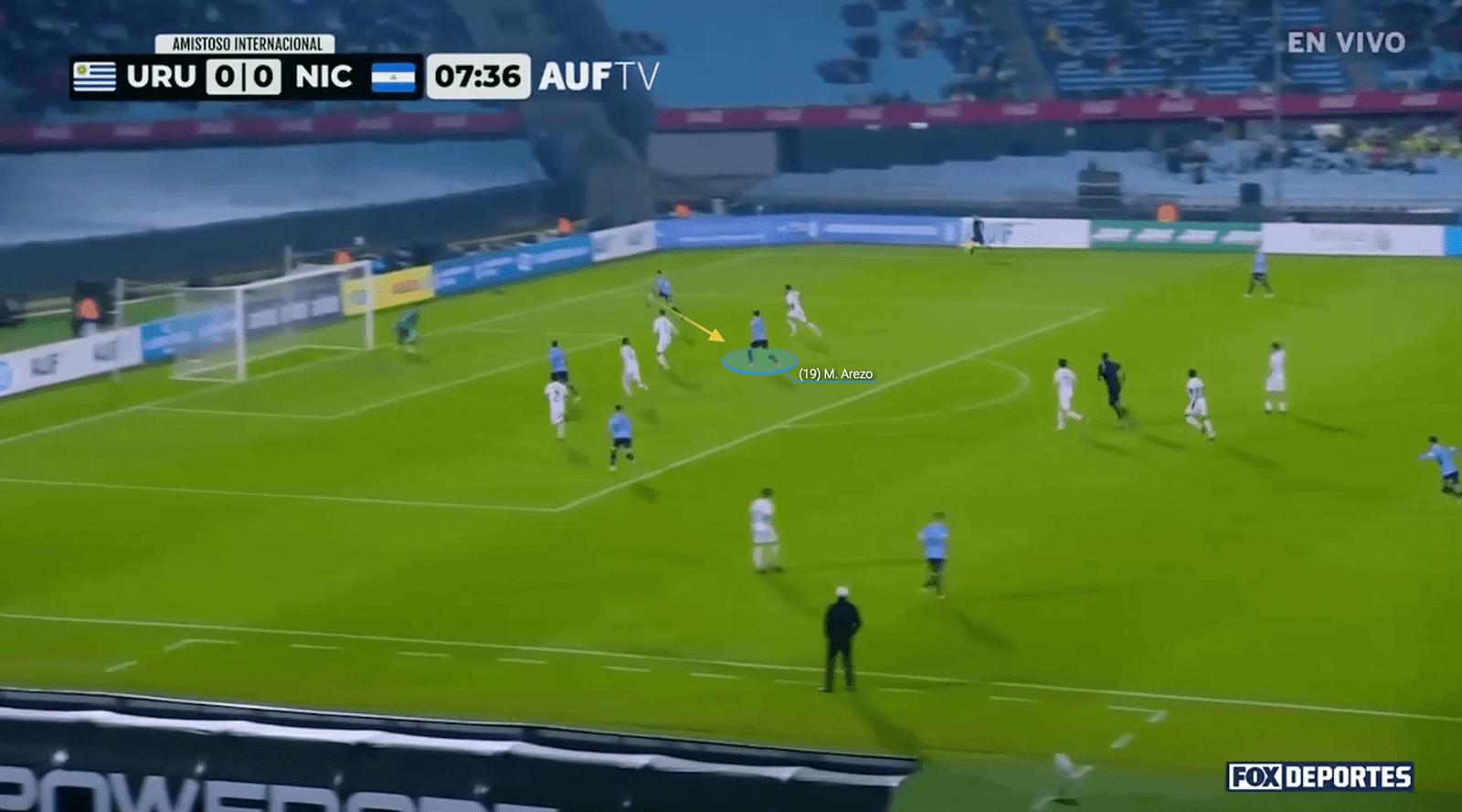
For tougher assignments, Uruguay are all about dogged defending and quick, pitch-sweeping transitions.
In their famous victory over Argentina, all six of their attempts on goal came from either a turnover in possession or a long pass in behind. Nunez spurned the below opportunity early on but would seal the 2-0 win with a similar counter-punch as their opponents sought an equaliser.
Even when Uruguay are bunkered in — they saw just 36 per cent of the ball in Buenos Aires — Nunez is a thorn in any territorially dominant side; only Mohamed Salah has taken more shots from fast breaks since Nunez landed in the Premier League.
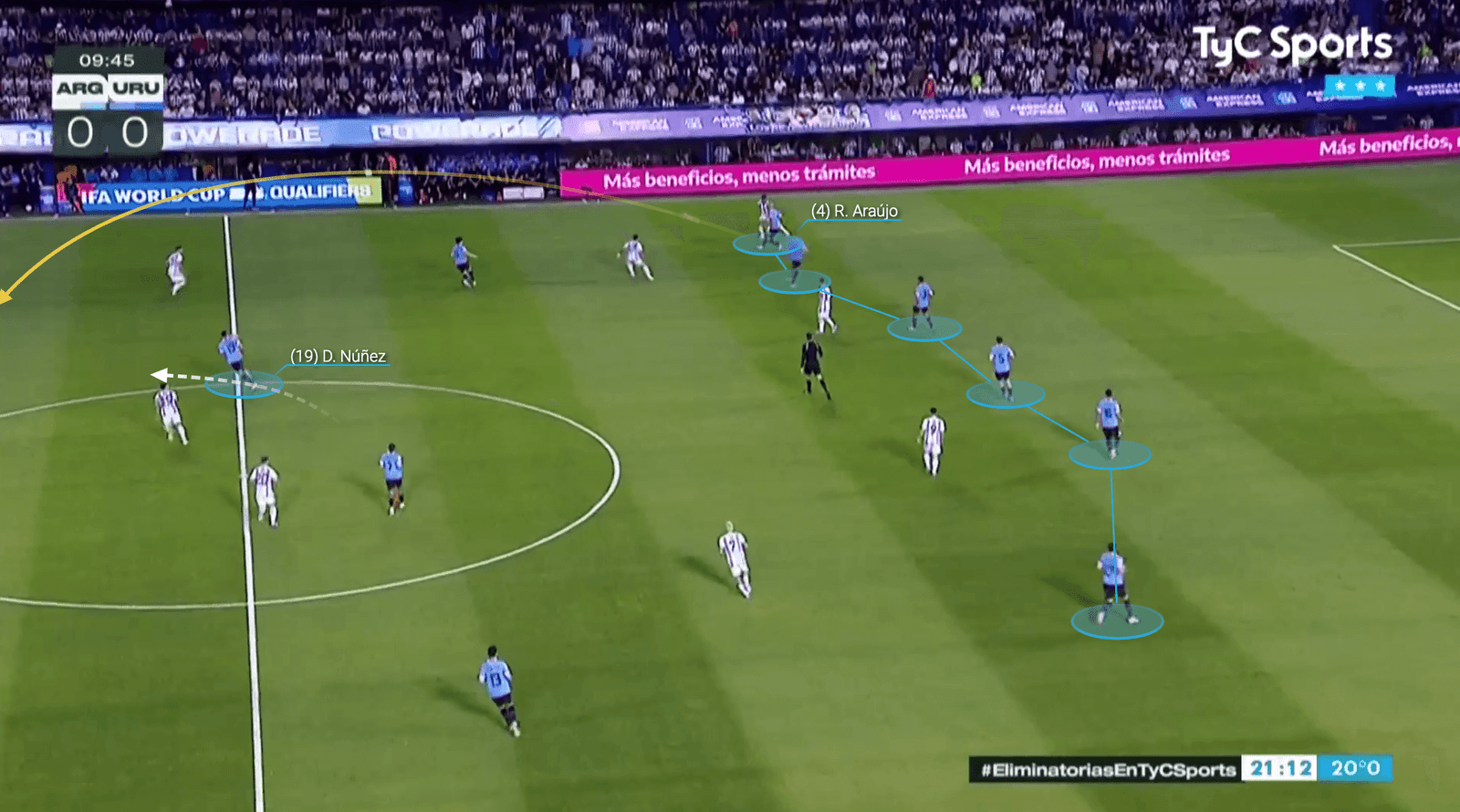
Nunez also led the charge against Chile after Ugarte raced out of midfield to apply pressure.
Chile’s Erick Pulgar let the ball slip under his foot and Bielsa’s side were away. Valverde tore up the pitch and slipped through the Liverpool forward, who laid the ball on a plate for Nicolas De la Cruz to score in under 10 seconds.
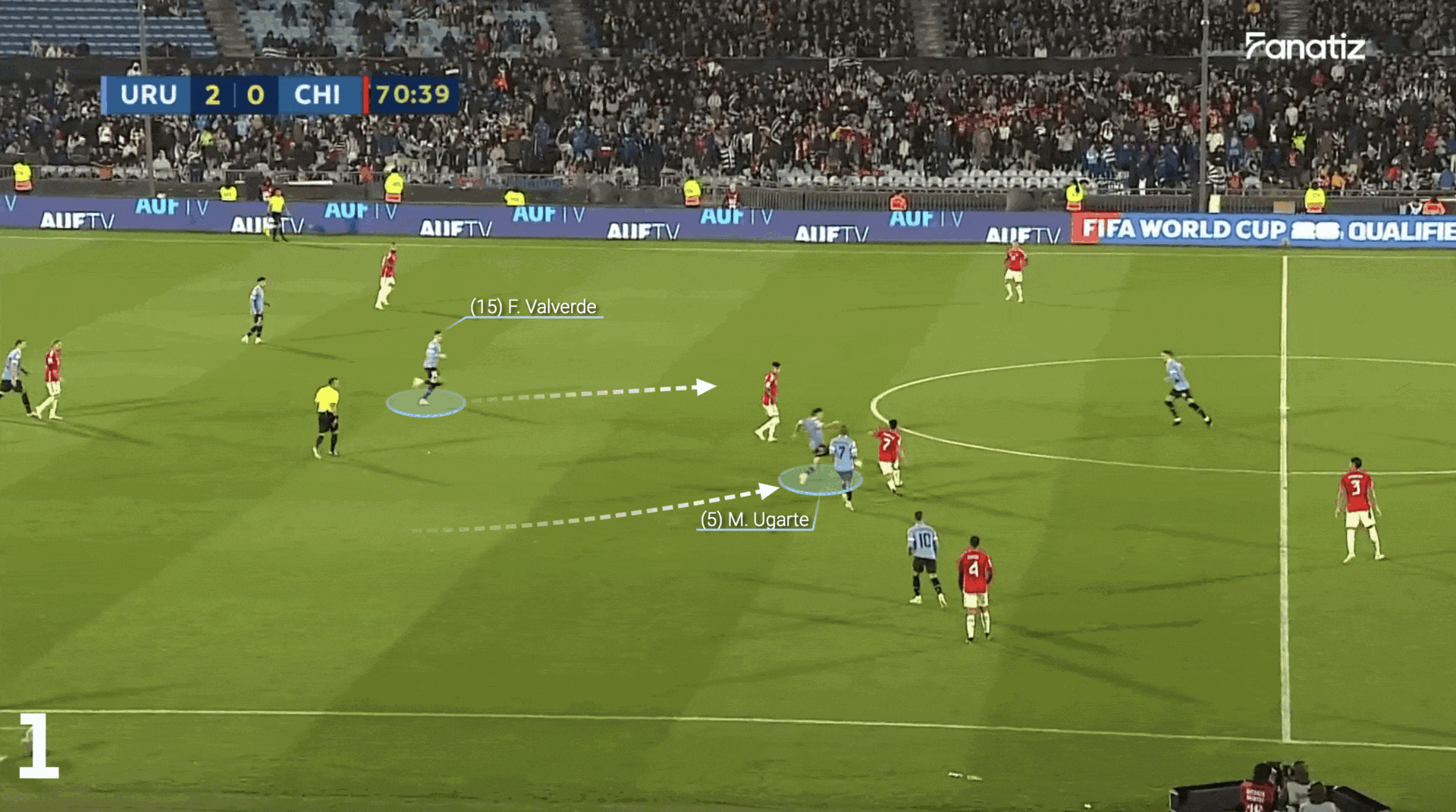
Uruguay have shown that they can win games with dominant possession football and resolute defensive displays, which makes them a danger to anyone.
What are their weaknesses?
As we saw during Bielsa’s stint with Leeds United, his bold out-of-possession approach can leave space to attack if the press is not perfect. His final Premier League game in charge, a 4-0 defeat to Tottenham in February 2022, saw his side reach 60 goals conceded after just 26 games.
Uruguay will mark man-to-man, usually doubling up on the opposition striker, as below. That always leaves a spare man, usually a centre-back (in yellow), who can cause havoc if they are confident enough to stride into midfield.
Rotation in the opposition build-up can also mean that players are pulled into unusual positions, as left-back Matias Vina finds himself chasing Argentina’s Rodrigo de Paul into the attacking third.
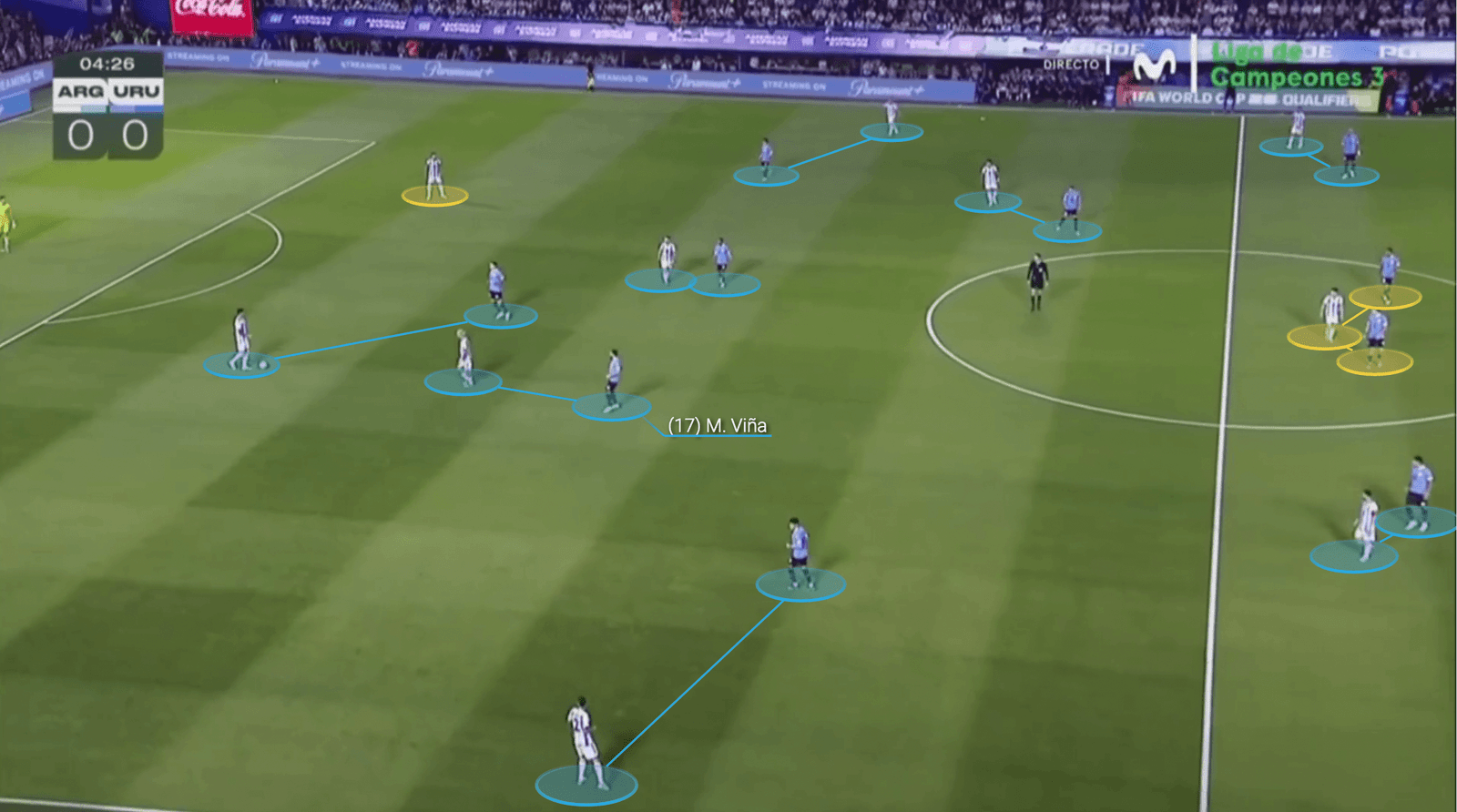
Swirling movement can pull Uruguay all over the pitch, but with the physicality of their players, you also need quick-thinking and bravery to capitalise on any moments of uncertainty.
Who are the key players?
Nunez and Valverde will grab the attention, but De la Cruz arrives at the tournament in red-hot form. His creativity and daring progressive play have fuelled a storming start to the season for Brazilian side Flamengo.
The 27-year-old is versatile, switching between deep-lying playmaker and box-crashing roles while equally capable out wide. For his country, he has enjoyed a free role behind the striker, drifting into pockets of space to propel the team forward and arriving into the penalty area to sweep the ball home.
De la Cruz can hit the ball, too, capable of whipping in a mean free kick for towering centre-backs to attack, or even striking at goal himself.
For all the pace and power of this Uruguay team, their diminutive yet technical two-footed No 10 packs as much of a punch as anyone.

(Guillermo Legaria/Getty Images)
Look out for…
Ronald Araujo at right-back.
The centre-half suggested that he does not like playing on the flank earlier in the season, but he looks to have made the role his own under Bielsa, even popping up at the back post to score the opener against Argentina.
Araujo is usually only utilised on the flanks at club level against Vinicius Junior, with Barcelona looking to exploit his exceptional one-on-one abilities to nullify the Brazilian’s relentless dribbling. They could renew rivalries in the knockout stages should both Uruguay and Brazil progress.
USMNT
- Manager: Gregg Berhalter
- Captain: Christian Pulisic
- Competitive post-World-Cup record: P13 W9 D3 L1 GF38 GA8
- 2022 World Cup: Round of 16
- Most caps in squad: Christian Pulisic (68)
- Top scorer in squad: Christian Pulisic (29)
How do they play?
With a home World Cup on the horizon, the United States have reached a crucial checkpoint.
Gregg Berhalter’s tenure — as dramatic as it has been — has been all about preparing for a future that has nearly arrived, slowly integrating younger players into the national team setup to build a competitive squad for 2026. The Copa America is a dress rehearsal and a real opportunity for those on the fringes to stake their claim.
Having won the CONCACAF Nations League for a third successive time in March, the mood is positive, despite a tough encounter with Jamaica in the semi-final. Regardless, it was a game that illustrated the flexibility of Berhalter’s possession-based 4-3-3, particularly in midfield.
What was once an undisputed trio — Yunus Musah and Weston McKennie flanking the combative Tyler Adams in the trusted “MMA” combination — is feeling competition from Malik Tillman, Johnny Cardoso and Gio Reyna, each bringing a different skill set to the table.
Amid injury concerns and tactical tweaking, the only certainty of the three is McKennie; his tempo-setting qualities and positional intelligence bring balance to the midfield and allow USMNT to rotate positions during build-up.
Although nominally a right-sided No 8, the Juventus man continually dropped into the back line to cover for advancing defenders against Jamaica, filling in for Antonee Robinson in the first half as below…

… before moving out to right-back to allow Berhalter to switch the midfield three after the break.
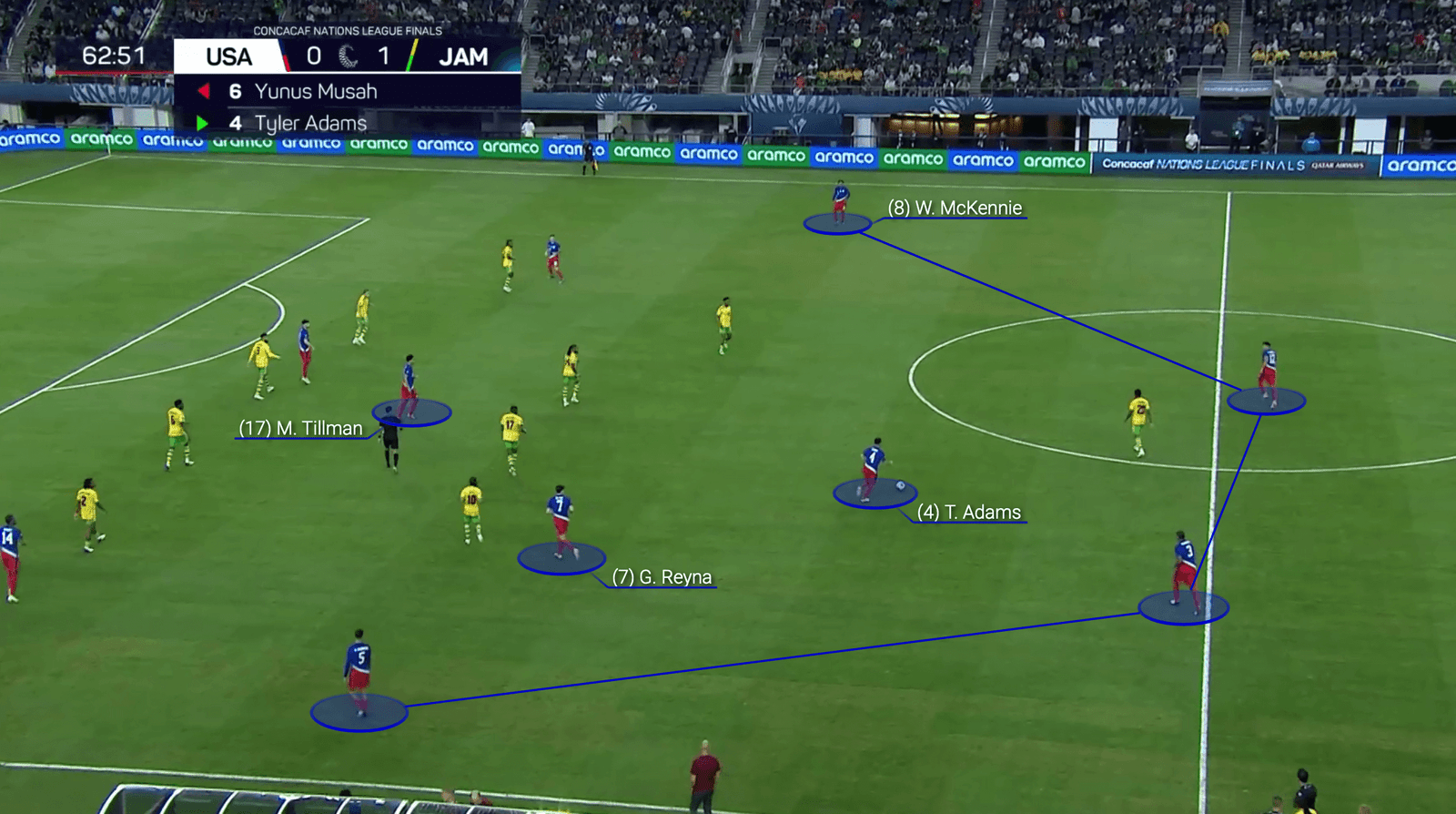
With Adams back in that anchoring role in the final half-hour, the U.S. could confidently push the full-backs high and wide, while allowing Reyna a free role up ahead. The 21-year-old blew the game open, providing two assists and a forward drive sorely lacking in the first half.
Drifting all across the final third and demanding the ball in dangerous areas, Reyna looked particularly potent at the heart of a left-sided triangle with Robinson and Haji Wright, both willing runners in behind.
He created a chance moments after the triple substitution; Adams illustrated not only how his defensive presence can allow the U.S. to push on, but how his incisive progressive passing can break lines and set his side on the attack in frame one.
Reyna is quick to control the pass in a pocket of space, spin, and slide the ball through to Wright, who flashes the shot wide…
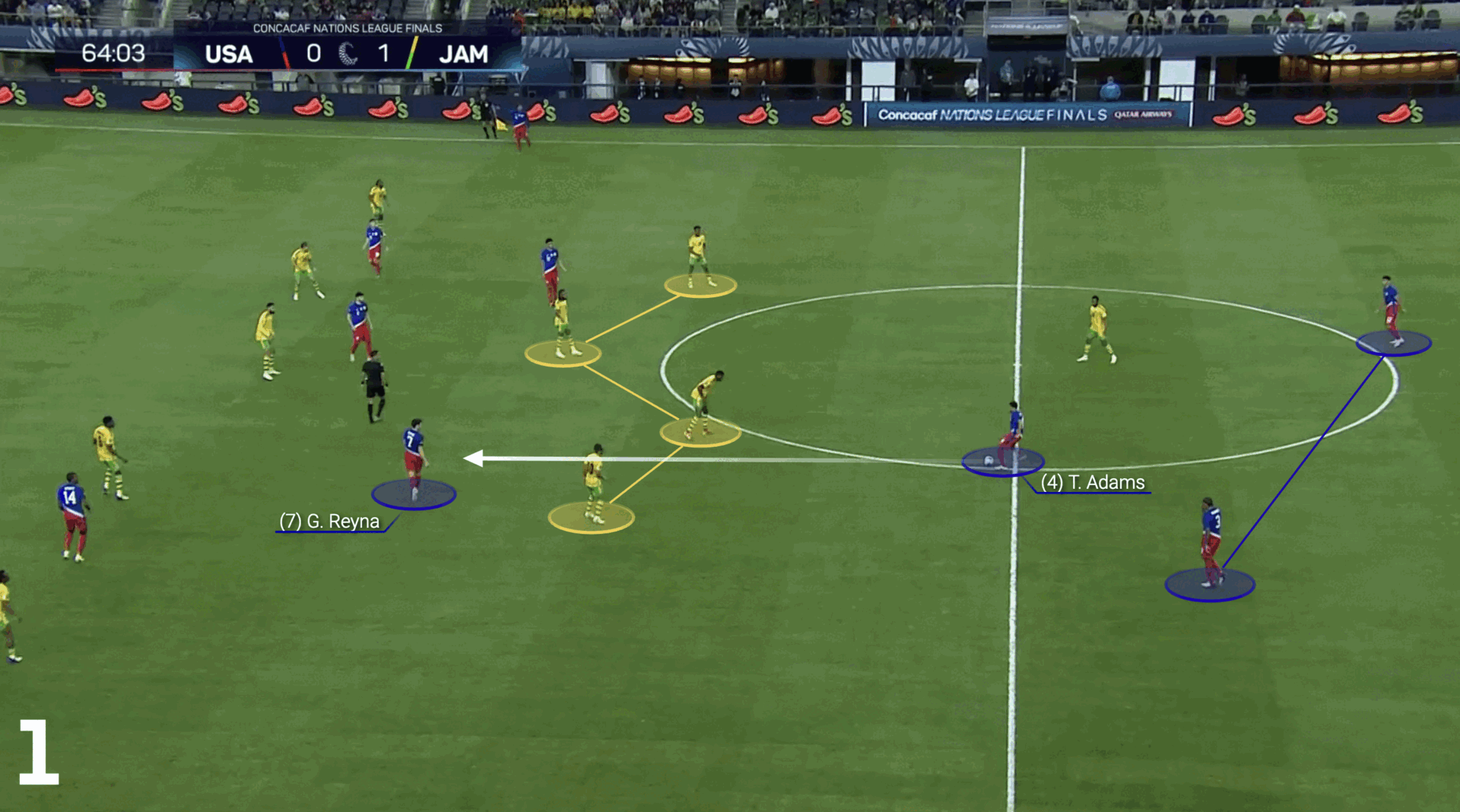
If Reyna has played his way into contention, Berhalter’s decision to take Adams off around 40 minutes after bringing him on points to the coach’s concerns about his fitness. That could open the door for Cardoso to step in and share the workload.
After a winter move to Real Betis, Cardoso made more interceptions per game (2.2) than any other player in La Liga, while also ranking seventh across midfielders for tackles (3.2) and second for true-tackle win-rate (64.7 per cent) — proving that he offers more-than-capable defensive cover.
Six high-quality midfield options and none older than 25 years of age. It bodes well for 2026.
What are their weaknesses?
Berhalter described his full-backs as the “superpower” of the team before the World Cup, but they will be without one of their turbo-engines this summer.
A serious knee injury for Sergino Dest has ruled him out of the Copa America, and while 21-year-old Joe Scally is an extremely capable replacement, he does not get forward with the same zip.
Dest has a wealth of experience across three European leagues and loves to charge upfield with the ball at his feet and initiate those quick combinations. Berhalter could look to drop Timothy Weah into that role, or even look at playing McKennie there, but the right side will not be as naturally forward-thinking as the left.
Elsewhere, there are a few starting places up for grabs, with the centre-forward position a particularly hot topic.
Folarin Balogun is understandably the first choice after his 21-goal season for Reims in 2022-23, but his patchy form at Monaco this season, along with a run of unconvincing performances for the USMNT, is leaving many wondering if Ricardo Pepi or Josh Sargent deserve their shot — albeit the latter is recovering from another ankle injury.

Folarin Balogun struggled with Monaco in 2023-24 (Rich Storry/Getty Images)
There is also a debate as to who should partner Chris Richards at the heart of defence, while goalkeeper Matt Turner was not hugely secure for Nottingham Forest this season, conceding 5.9 goals more than the quality of shots he faced suggested he should have. Having said that, his 11-save performance to salvage a draw against Brazil last weekend will fill the shot-stopper with confidence.
Nothing disastrous, but enough to sew a few seeds of doubt as Berhalter searches for a winning formula.
Who are the key players?
His manager wasn’t exaggerating; left-back Robinson offers unrivalled forward momentum on the ball, a powerful runner and a reliable outlet to get the U.S. up the pitch.
He is also strong defensively, a masterful reader of the game who completed more interceptions than any other player in Europe’s top five leagues last season.
Let’s not forget about Christian Pulisic either, arriving at the Copa America in his most prolific form. A move to AC Milan has reinvigorated the USMNT captain, registering 12 goals and eight assists in a hugely satisfying debut season in Serie A.
As the below graphic shows, he is Mr Consistent on the international stage and might well be ticking into his prime.
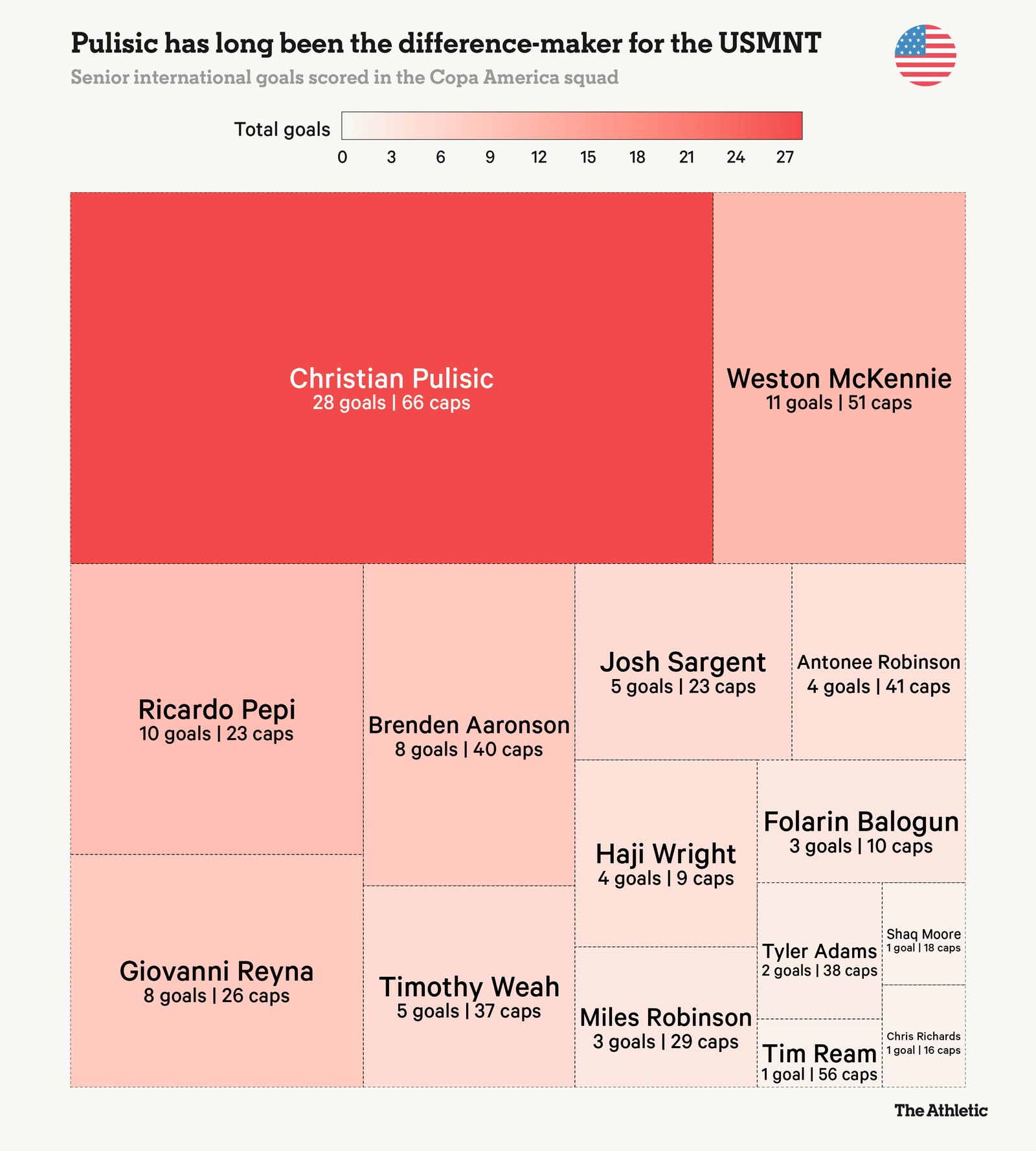
Look out for…
How the U.S. adapt from game to game.
Berhalter faces three very different propositions in a fascinating Group C: a tough-tackling low block from Bolivia, a battle for possession with Panama, and an intense game of transitions against Uruguay.
With plenty of tactical options throughout the squad — Weah vs Scally to cover for Dest, the ball progression and the experience of Tim Ream vs the athleticism of Miles Robinson at the back — expect to see tweaks to the setup with each tactical challenge.
Bolivia
- Manager: Antonio Carlos Zago
- Captain: Luis Haquin
- World Cup qualifying: P6 W1 D0 L5 GF4 GA14
- 2021 Copa America: Group stages
- Most caps in squad: Carlos Lampe (55)
- Top scorer in squad: Rodrigo Ramallo (7)
The odds are not exactly stacked in Bolivia’s favour this summer.
Having won just one of their last 30 games at the Copa America, La Verde have gone home with zero points in seven of their last eight tournaments. Coincidentally, that shock 3-2 win over Ecuador back in 2015 was also their last competitive victory away from the Estadio Hernando Siles, their iconic home stadium that sits almost 12,000 feet (3,700metres) above sea level in the mountainous capital city of La Paz.
Without altitude on their side, Bolivia will also be missing their record appearance maker and goalscorer Marcelo Martins this summer, after the 36-year-old announced his retirement last year. He outscored Lionel Messi, Luis Suarez, Neymar — everyone — in the last round of World Cup qualifying and more international goals (31) than the entire provisional squad he has left behind (22).
Heat and humidity will not make their aggressive off-the-ball approach any easier either, tasked with stopping the tournament hosts on matchday one in Texas, before taking on pre-tournament favourites Uruguay and possession-heavy Panama on the East Coast. All signs point to a difficult summer slog.
There are a handful of reasons to be optimistic, however, including a positive start under new head coach Antonio Carlos Zago. Of his first four games in charge, Bolivia won two, beating Peru in World Cup qualifying and Andorra in a friendly, while only falling to a stoppage-time defeat in Algeria.
The Brazilian has focussed on packing the midfield with bodies, defending in a 4-5-1 shape that can easily become a 4-4-2 if a midfielder pushes up to press, or a 5-4-1 if one drops into the defensive line.
In that crucial win over Peru, his team made it difficult for their opponents to progress through the middle with a high-intensity man-to-man system, shown here as centre-back Jose Sagredo chases Peru striker Gianluca Lapadula into midfield. They have completed more interceptions than any team in CONMEBOL World Cup qualifying so far, showing their intent to impose themselves in the middle.

With much less of the ball against Uruguay — around 31 per cent — that defensive tenacity was maintained, with athletic midfielders Gabriel Villamil and Ramiro Vaca springing out of the defensive shape to track runners all across the pitch.

The downside to that approach is that Bolivia can be pulled apart if high-quality opposition can stretch the pitch and string together quick passing combinations.
In frame one below, Uruguay have worked the ball out to Matias Vina. That draws the pressure of wide player Rodrigo Ramallo, while the advanced Villamil tears back into midfield to pick up Nicolas de la Cruz.
With a quick one-two, the left-back can charge through the defensive line, his forward momentum taking him past three players who have just sprinted into new positions and are unable to react.


Underestimate Bolivia’s commitment and collective spirit at your peril; there will be big challenges and tireless defensive efforts to stop teams playing through them.
But they can overcommit and unlike Uruguay do not possess the technical quality to control games if Plan A does not come off. They will surely tire from chasing the ball in the heat if they continue to cede two-thirds of the possession to their opponents.
What are their weaknesses?
Creating chances.
Bolivia are a defensive side who often go long and direct when they get a chance to attack. In six World Cup qualifying games so far, they have made the fewest passes and recorded the lowest passing accuracy, averaging just 4.7 touches of the ball in the attacking penalty area per game.
Without the towering presence of Martins up top, they lack a high-quality target man and will need to be more precise if they are to find Carmelo Algaranaz and Vaca in behind.
Their shot map from qualifying also suggests that they let fly too quickly, even if they do possess some capable players from distance.
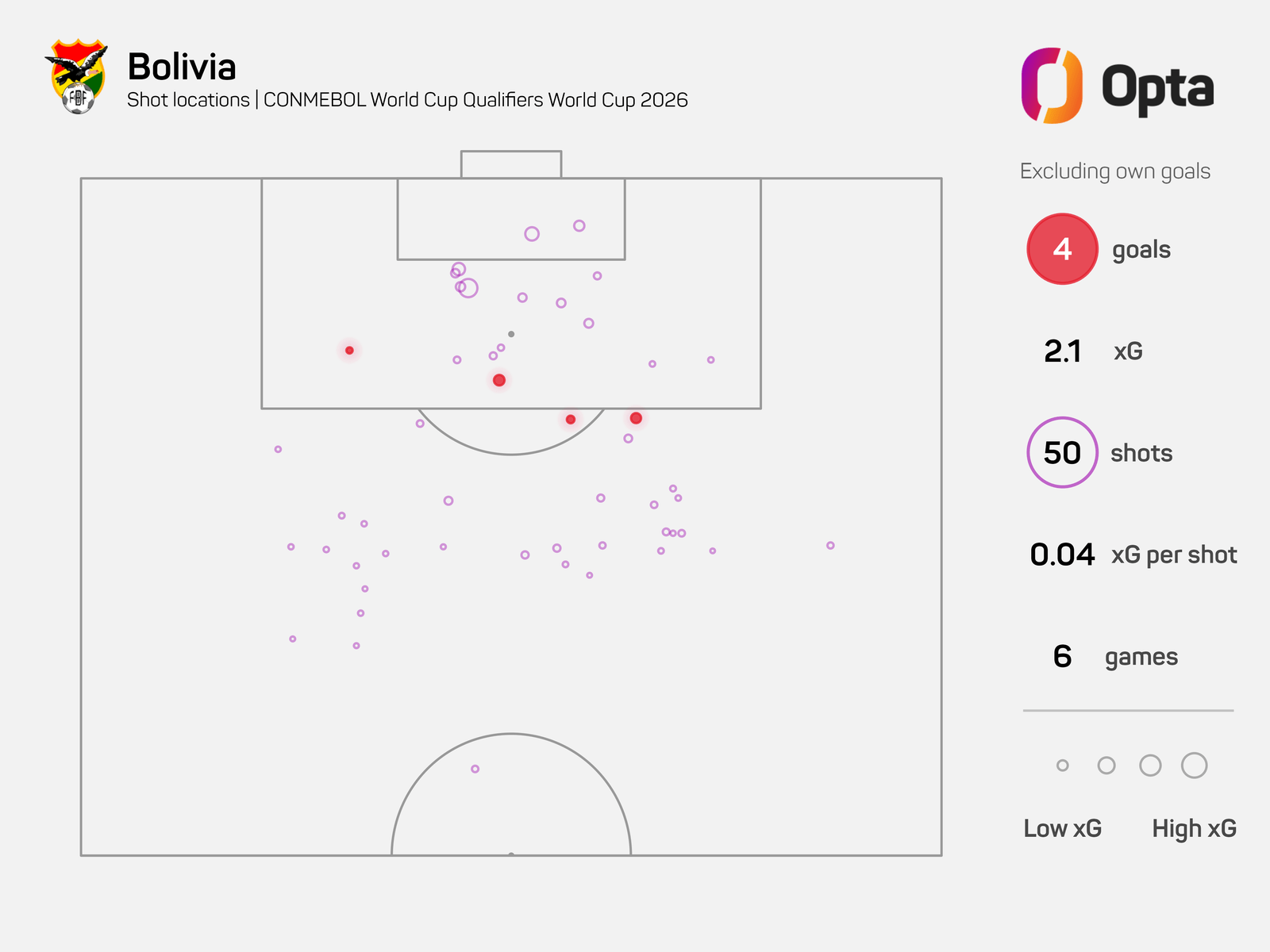
An average xG per shot of 0.04 is extremely low and partly explains, after Martins’ retirement, that the top scorer in this squad has just seven goals.
Who are the key players?
Ramiro Vaca is a lively attacking player, able to scamper forward from a left-sided midfield role and strike the ball cleanly on his right foot. He has averaged 3.5 shots per game for Club Bolivar this season, while only four players have averaged more passes into the final third in the division, per Wyscout.
He is not to be confused with Henry Vaca, a similarly tigerish midfield player, while Villamil is just 22 and has impressed with his versatility and energy so far.
Then, it is all eyes on the defence. Jose Sagredo is the reliable veteran, Luis Haquin is the strong, tall captain, and Guillermo Viscarra is the chief shot-stopper. All are likely to be very busy this month.

Ramiro Vaca is a lively option for Bolivia (Richard Pelham – FIFA/FIFA via Getty Images)
Look out for…
We mentioned it at the top, but Bolivia’s away record is reaching historic lows.
La Paz is understandably a high-altitude fortress, but they have only won two competitive games away from home in the last 29 years: Ecuador in 2015, and the U.S. at the Copa America in 1995.
They will have a historic repeat in their sights on June 23rd.
Panama
- Manager: Thomas Christiansen
- Captain: Anibal Godoy
- World Cup qualifying: P2 W2 GF5 GA1
- 2016 Copa America: Group stage
- Most caps in squad: Anibal Godoy (141)
- Top scorer in squad: Jose Fajardo (11)
Thomas Christiansen had lofty ambitions when he took on the Panama job in 2020.
“In addition to having my own style, I want to help change football in the country,” he recalled promising the hiring committee in a piece with The Coaches’ Voice.
Four years, and a Gold Cup final later, Los Canaleros head into their second Copa America as — arguably — CONCACAF’s third-strongest team.
During Christiansen’s tenure, Panama have risen almost 40 places in the FIFA rankings (they are now ranked 45 in the world) and have unveiled plans for a shiny, new high-performance training centre, with the future of Panamanian football firmly in mind. It is fair to say that his development project is on track.
On the pitch, Christiansen has implemented a possession-heavy style, building up patiently with three central defenders and two holding midfielders, while touchline-hugging wing-backs and persistent central runners look to test the opposition’s defensive resolve.
Panama are very happy to recycle possession across the back line, with centre-backs Andres Andrade and Fidel Escobar dropping into wide areas and looking to hold onto the ball to tempt pressure onto them, as they did against Costa Rica below.

Such sequences can cause problems for the opposition: not only are they stretched horizontally as they try to match Panama’s width, they need to stay compact vertically if they want to step up and press.
In this example, Panama keep the ball for almost two minutes, with 10 passes between the centre-backs sending the ball from left to right and keeping the opposition shuffling across.
Finally, with each of Costa Rica’s five defenders occupied, Fajardo drops deep to pull a defender away, while Ismael Diaz charges in behind. Andrade finds his striker with a ball over the top, but he fails to convert.
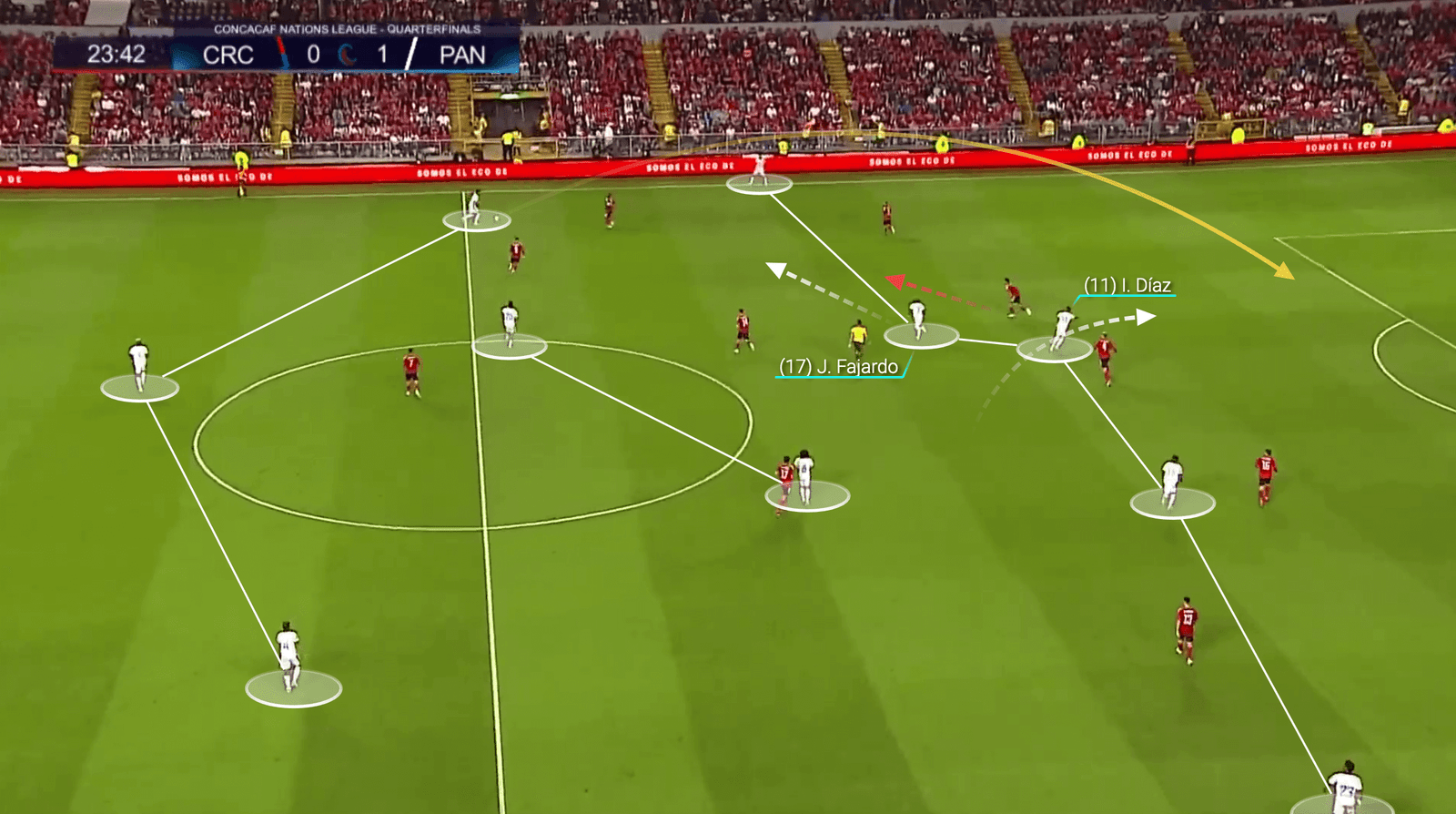
“We want to dominate and control matches and take the game where we want it,” says Christiansen. “A player on the ball has to have three or four passing options — if he doesn’t have that, then his team-mates aren’t offering him those solutions.”
Such is the extent of Panama’s patience, that they are marked outliers in CONCACAF for the high number of passes that they average per sequence and the low speed in which they move the ball towards goal, as their numbers from their second-place finish at the Gold Cup show.
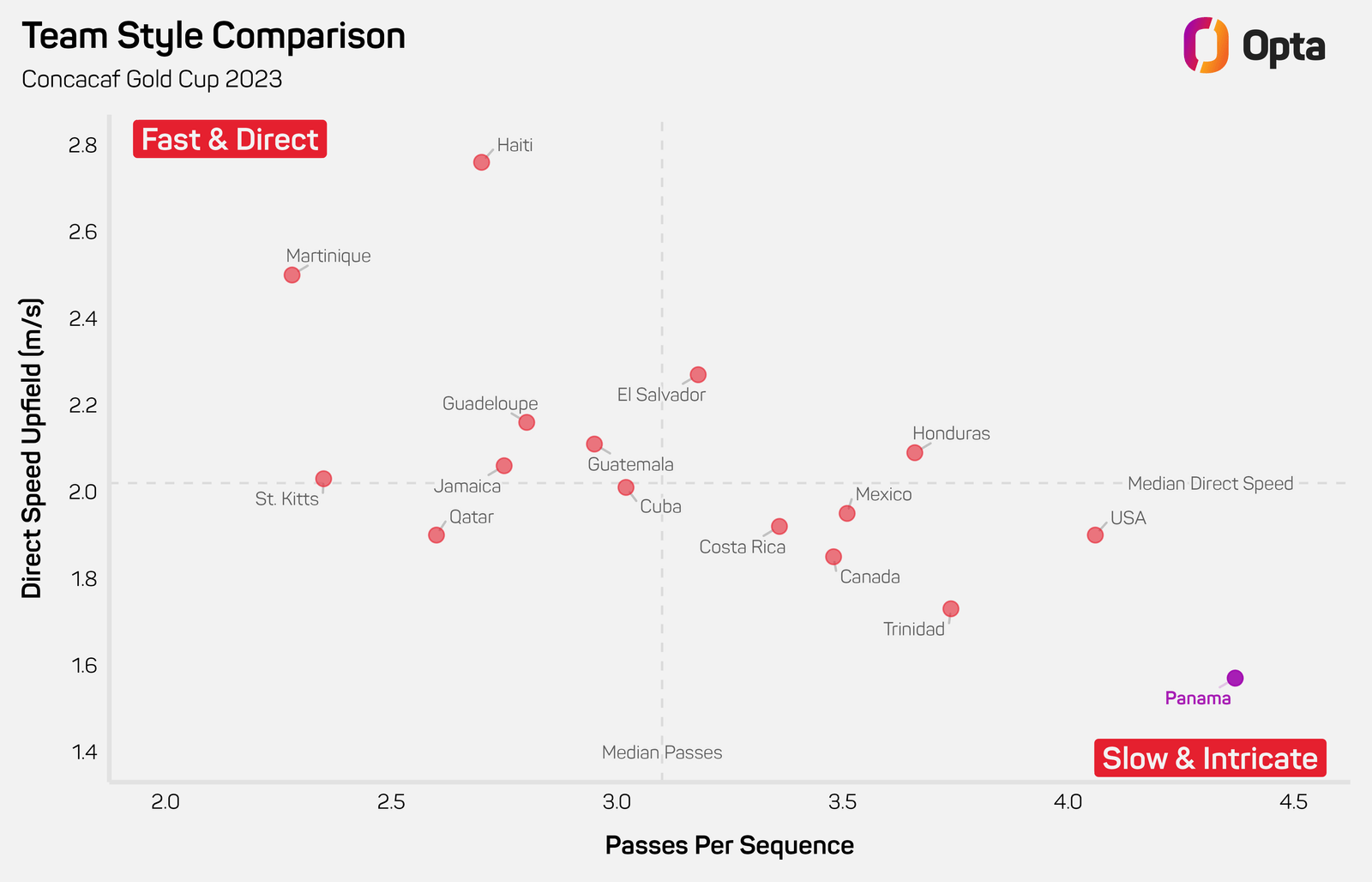
As wholesale as the improvement has been, possession of the ball does not always guarantee success. They can be frustrated, as they were against Jamaica in March, struggling to find solutions against a stubborn block that could compete with their physicality in midfield.
Here, Panama’s two receivers, Godoy and Adalberto Carrasquilla, are aggressively man-marked, unable to consistently find space to receive the ball. In reaction, attacking player Jose Luis Rodriguez drops deep to offer himself for the pass, but centre-back Jose Cordoba waves him forward and turns away.
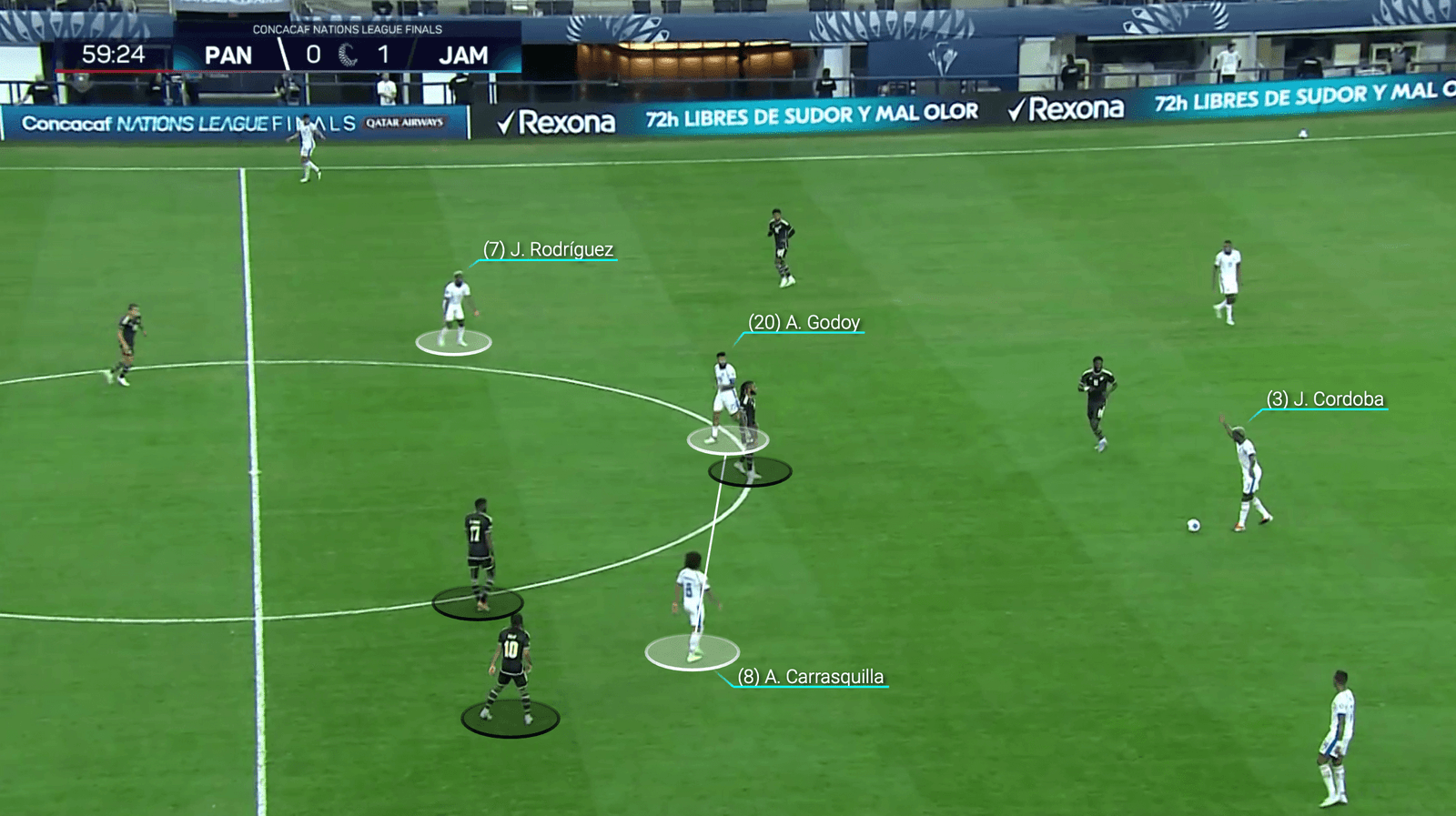
Instead, he plays a short pass into Carrasquilla, but Damion Lowe is switched on and nips in ahead to intercept the ball. He goes on to hit the crossbar with an ambitious lob, and Carrasquilla is not best pleased.
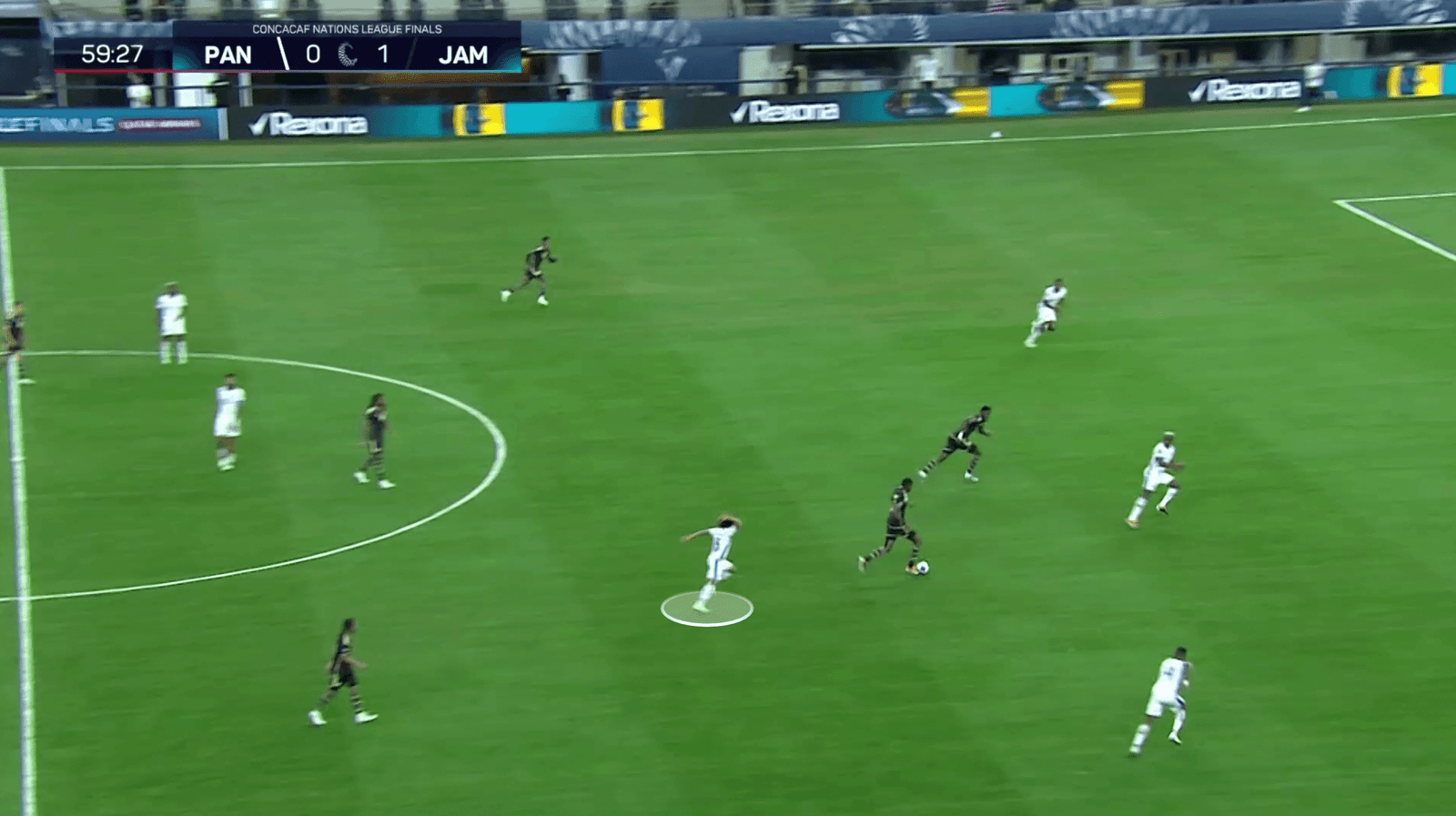
Panama will likely have more of the ball in all three of their group games this summer, but they need to be wary of the sucker punch.
What are their weaknesses?
Defending dead-ball deliveries.
Panama allow too many free headers from swung-in set pieces: four of their last seven goals conceded have been headers from inside the box. Mexico’s Edson Alvarez had two clear-cut chances in the first half alone in the Nations League semi-final, nodding his second opportunity home just before the break.
They can also be undone by long balls over the top, particularly when they are pushing up the pitch themselves. Mexico’s third goal in that 3-0 defeat was an alarming example, as Cesar Montes clipped a perfect pass over to Orbelin Pineda, who had time to bring the ball down and finish in behind the defensive line.
Who are the key players?
When Panama are purring, Carrasquilla is one of those all-action midfielders who makes the game look easy — everywhere, all at once, without seeming to break a sweat.
The 25-year-old has quickly become a fan-favourite for club, country, and neutrals alike, combining defensive spirit with creative swagger. His stocky build and neat touch make him tricky to knock off the ball, while an innate sense of positioning means that he is constantly putting out fires in the middle third.

(Ron Jenkins/Getty Images)
In possession, Carrasquilla is always looking to move the ball forward and while he plays a deeper, more conservative role for his country, his desire to constantly test the defensive line with his passing still stands out.
As we can see from his progressive pass cluster below, illustrating his most common passes that move the ball at least 25 per cent closer to the centre of the opposition goal since he joined Houston Dynamo in 2021 (first on loan), he will pepper the penalty area from all across the pitch.

Alongside him, captain Godoy, 34, brings security in possession — only six midfielders in MLS can better his turnover rate of 11.9 per cent since the start of last season for Nashville, suggesting that he loses possession infrequently for how often he touches the ball.
Wing-back Michael Murillo brings pace and penetration down the right flank, while centre-forward Diaz is a handful when he peels in behind the defensive line — but you can’t miss Carrasquilla orchestrating everything from midfield.
Look out for…
The first goal.
Panama’s style allows them to see out leads with patient possession play, but they can struggle to break down sides who drop deeper with a lead to protect.
Since the start of 2023, Panama are yet to lose after going ahead, but yet to win after going behind. Getting at them early might be your best chance.
(Top photos: Getty Images; design: Eamonn Dalton)
Read the full article here


